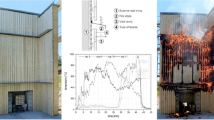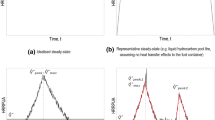Abstract
In this article, a previous mechanical model is extended to predict raceway penetration in a blast furnace (BF) and to dynamically illustrate how raceway penetration varies over time after the blast velocity varies based on Newton’s second law. The model is validated by industrial measurements, and more precise predictions have been obtained using the present model. Moreover, the effects of combustion reactions on the raceway shape and size are taken into account in the present model. The mechanism for raceway formation and variation revealed by the present model is as follows: Fast movements of packed bed above a raceway roof due to blast blowing rate variation make raceway size vary rapidly and form its prototype; combustion reactions modify raceway size and shape, and they maintain its stability.








Similar content being viewed by others
Abbreviations
- \( c_{{{\text{O}}_{2} }} \) :
-
concentration of oxygen in raceway, mol/m3
- \( C_{\text{R}} \) :
-
coke ratio, given as 300 kg/tFe
- \( D \) :
-
raceway diameter, m
- \( D_{\text{T}} \) :
-
tuyere diameter, m
- \( d_{\text{p}} \) :
-
particle diameter, given as 0.03 m
- \( g \) :
-
the acceleration due to gravity, 9.813 m/s2
- \( h \) :
-
factor arising due to resolution of vertical force along the radial direction, whose value is the same with p
- \( H \) :
-
effective height of packed bed, m
- \( K \) :
-
lateral pressure coefficient
- \( k_{\text{g}} \) :
-
mass transfer coefficient of oxygen, m/s
- \( M \) :
-
bed weight per unit volume, N/m3
- \( M_{C} \) :
-
molar mass of carbon, kg/mol
- \( n \) :
-
factor contributing to the total area of the raceway
- \( N \) :
-
tuyere number
- \( p \) :
-
factor arising due to resolution of radial force along the vertical direction
- \( P \) :
-
blast pressure, Pa
- \( P_{0} \) :
-
atmospheric pressure, Pa
- \( P_{1} \) :
-
top pressure of blast furnace, given as 150 kPa
- \( r_{0} \) :
-
radius of radial region, m
- \( R \) :
-
radius of raceway, m
- \( R_{0} \) :
-
initial raceway radius, m
- \( R_{0}^{'} \) :
-
raceway radius when packed bed just stop moving, m
- \( T \) :
-
blast temperature, K
- \( T_{0} \) :
-
room temperature, K
- \( T_{1} \) :
-
top temperature to blast furnace, K
- \( W \) :
-
hearth diameter, m
- \( V \) :
-
volume of blast furnace, m3
- \( V_{b} \) :
-
blast velocity, m/s
- \( V_{b0} \) :
-
blast flow rate, m3/min
- \( V_{H} \) :
-
gas velocity above hearth, m/s
- \( \eta \) :
-
coefficient of the viscosity of air, kg/(m·s)
- \( \rho_{\text{c}} \) :
-
coke density surrounding raceway, kg/m3
- \( \rho_{\text{g}} \) :
-
gas density, kg/m3
- \( \rho_{0} \) :
-
gas density at standard conditions, kg/m3
- \( \rho_{\text{s}} \) :
-
particle density, given as 1050 kg/m3
- \( \xi \) :
-
void fraction of packed bed given as 0.03
- \( \mu \) :
-
coefficient of friction between the particle–particle
- \( \mu_{w} \) :
-
coefficient of friction between the particle wall
- \( \phi_{w} \) :
-
angle of friction between wall particles, given as 20 deg[15]
- \( \phi \) :
-
internal angle between the particles, given as 32 deg[15]
- \( \psi \) :
-
shape factor of particles, given as 0.7
- \( \tau_{\text{w}} \) :
-
particle–wall frictional shear stress, N/m2
- \( \tau \) :
-
particle–particle frictional shear stress, N/m2
- \( \sigma_{\text{r}} \) :
-
radial stress, N/m2
- \( \Upomega \) :
-
coefficient of utilization of useful capacity of blast furnace, given as 2.3t/(m3d)
References
V.B. Apte, T.F. Wall, and J.S. Truelove: AIChE, 1990, vol. 36, pp. 461-68.
S. Sarkar, G.S. Gupta, J.D. Litster, V. Rudolph, E.T. White, and S.K. Choudhary: Metall. Mater. Trans. B, 2003, vol. 34B, pp. 183-91.
G.S. Gupta, S. Rajineesh, V. Rudolph, V. Singh, S. Sarkar, and J.D. Litster: Metall. Mater. Trans. B, 2005, vol. 36B, pp. 755-64.
J. Taylor, G. Lonie, and R. Hay: Iron. Steel Inst., 1957, vol. 181, pp. 330-36.
M. Hatano, B. Hiraoka, M. Fukuda, and T. Masuike: Trans. Iron Steel Inst. Jpn., 1977, vol. 17, pp. 102-09.
M. Nakamura, T. Sugiyama, T. Uno, Y. Hara, and S. Kondo: Tetsu-to-Hagané, 1977, vol. 63, pp. 25-28.
J. Guo, S.-S. Cheng, and P.-Y. Du: Proc. 13 th Metallurgical Reaction Engineering Meeting, Baotou, China, 2009, pp. 179–86.
J. Guo and S.-S. Cheng: Proc. 10 th Nationwide Blast Furnace Ironmaking Annual Conference, Taiyuan, China, 2009, pp. 521–27.
S. Rajneesh, Sarkar, and G.S. Gupta: ISIJ Int., 2004, vol. 44, pp. 1298–1307.
S. Ergun: Chem. Eng. Prog., 1952, vol. 48, p. 89.
H.A. Janssen: Ver. Deutsch. Ing. Z., 1895, vol. 39, pp. 1045–49.
Y. Yang and J. Zhu: Acta Metall. Sin., 1965, vol. 18, pp. 158-64.
G.S. Gupta and V. Rudolph: ISIJ Int., 2006, vol. 46, pp. 195-201.
V. Singh, G.S. Gupta, and S. Rajneesh: Ironmaking Steelmaking, 2006, vol. 33, pp. 101-10.
I. Takanobu, M. Yoshinori, Y. Masami, M. Shin-ichi, K. Shusaku, Y. Takaiku, and O.M. Onishi: ISIJ Int., 2003, vol. 43, pp. 1376-83.
The authors express their thanks to National Natural Science Foundation of China for their kind financial support (No. 61271303).
Author information
Authors and Affiliations
Corresponding author
Additional information
Manuscript submitted September 13, 2012.
Rights and permissions
About this article
Cite this article
Guo, J., Cheng, S., Zhao, H. et al. A Mechanism Model for Raceway Formation and Variation in a Blast Furnace. Metall Mater Trans B 44, 487–494 (2013). https://doi.org/10.1007/s11663-013-9833-9
Published:
Issue Date:
DOI: https://doi.org/10.1007/s11663-013-9833-9




